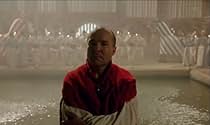A zsarnok szíve, avagy Boccaccio Magyarországon
- 1981
- 1 h 36 min
AVALIAÇÃO DA IMDb
6,7/10
202
SUA AVALIAÇÃO
Adicionar um enredo no seu idiomaA historical drama set in the 1400s, about a young man sent to Italy but is forced back after his father's mysterious death.A historical drama set in the 1400s, about a young man sent to Italy but is forced back after his father's mysterious death.A historical drama set in the 1400s, about a young man sent to Italy but is forced back after his father's mysterious death.
- Prêmios
- 1 indicação no total
László Gálffi
- Gáspár
- (as Gálffy László)
Géza D. Hegedüs
- Csuhás
- (as Hegedüs D. Géza)
- Direção
- Roteiristas
- Elenco e equipe completos
- Produção, bilheteria e muito mais no IMDbPro
Enredo
Avaliação em destaque
Among other Jancso films I've seen, this is perhaps closest to the relatively commercial "Private Virtues, Public Vices" in that it is to a degree visually lush high-end erotica aimed at international audiences, not least by casting "Caligula" star Teresa Ann Savoy, whose presence at this point guaranteed a certain kind of content. The story involves a naive young 14th-century Hungarian prince who is retrieved from Italy-where he seems to have fallen in with various parasitical pleasure-seekers including Pasolini's frequent star Ninetto Davoli-when informed that his father has been killed. There's a "Hamlet"-like feel to the somewhat murky political mechanizations that keep our heir-apparent hero in the dark as to just what happened to his father, whether his mother is killing young women (rather like Elisabeth Bathory), who his allies/enemies are, etc. Eventually, it seems, everybody kills everyone else, but instead of the real horror of a Jacobean revenge tragedy, it all feels like ritualistic play-acting.
Then again, narrative content is somewhat incidental to the formal spectacle here, in which "Italy" and "Hungary" scarcely seem different because everything is shot on theatrical soundstage sets, camera and actor movements are elaborately choreographed (with use of turntables and such on top of Jancso's usual complicated tracking shots), and lots of (almost entirely female) nudity. The result is an aesthetically defined and distinctive work of art, but more a sort of avant-garde theatrical experience designed for film than anything of emotional, narrative or thematic impact. The director's familiar stylistic choices aside, this is more like Derek Jarman's more elaborate costume fantasias such as "Caravaggio" in its heightened artificiality and eroticism, complete with lots of candles, "raining" feathers, and so forth. The effect is always handsome, if not much more.
Though this is not the kind of movie in which "acting" matters so much (the actors are often used like statuary, models, mimes or processions), the male lead has an unfortunately rather fatuous presence that would be better suited to one of the supporting-schemer roles. I'm not sure why he got so many leading roles in Hungarian films, but in any case he's the wrong choice here. Savoy is mostly deployed as a mute figure until she gets a few lines late in the going.
Then again, narrative content is somewhat incidental to the formal spectacle here, in which "Italy" and "Hungary" scarcely seem different because everything is shot on theatrical soundstage sets, camera and actor movements are elaborately choreographed (with use of turntables and such on top of Jancso's usual complicated tracking shots), and lots of (almost entirely female) nudity. The result is an aesthetically defined and distinctive work of art, but more a sort of avant-garde theatrical experience designed for film than anything of emotional, narrative or thematic impact. The director's familiar stylistic choices aside, this is more like Derek Jarman's more elaborate costume fantasias such as "Caravaggio" in its heightened artificiality and eroticism, complete with lots of candles, "raining" feathers, and so forth. The effect is always handsome, if not much more.
Though this is not the kind of movie in which "acting" matters so much (the actors are often used like statuary, models, mimes or processions), the male lead has an unfortunately rather fatuous presence that would be better suited to one of the supporting-schemer roles. I'm not sure why he got so many leading roles in Hungarian films, but in any case he's the wrong choice here. Savoy is mostly deployed as a mute figure until she gets a few lines late in the going.
- ofumalow
- 2 de set. de 2020
- Link permanente
Principais escolhas
Faça login para avaliar e ver a lista de recomendações personalizadas
- How long is The Tyrant's Heart?Fornecido pela Alexa
Detalhes
Contribua para esta página
Sugerir uma alteração ou adicionar conteúdo ausente

Principal brecha
By what name was A zsarnok szíve, avagy Boccaccio Magyarországon (1981) officially released in Canada in English?
Responda






















